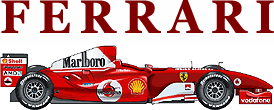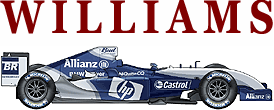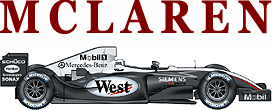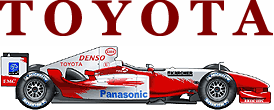 |
Scuderia Ferrari Marlboro
| First GP: | Monaco 1950 |
| GP Starts: | 686 |
| Wins: | 167 |
| Pole Positions: | 166 |
| Fastest Laps: | 167 |
| Drivers' Titles: | 13 |
| Constructors' Titles: | 13 |
|
When the F2003-GA was announced, Ferrari believed they had another car on their hands that could win just about every race it entered. In the event, it proved sufficient to win both Championships, but the fact it was taken down to the last race of the year demonstrated that the front runners had closed the gap - and in particular, that the Bridgestone advantage from the previous season was over.
The F2004 is a solid evolution of its predecessor. On the face of it, this seems conservative for a team that needs to show good progress in order to remain ahead of the chasing pack, but in practice, this is not a small step: the original car was fundamentally sound, so it makes a good basis for the new one: it is reliable, well understood, and already has a good interaction with the tyres.
Instead of throwing away what works, Ferrari have taken the opportunity to rework the weakest areas, reducing both the size and weight of the transmission. The new engine is more powerful than the old one, yet just as reliable. The mass has been kept down, though the cooling requirements are tough.
Despite being out of the limelight last year, Rubens Barrichello actually had a strong season, earning himself a two-year extension with the team. Whilst few believe he can consistently beat Michael Schumacher in the same car, he sees this year as yet another where he should win races, and could take the Championship if Schumacher falters. In the meantime, he plays the perfect teammate. Schumacher, of course, is expected to continue to play at the top of his game, and wring the best results possible out of the package.
Testing: The team has had up to four cars out at a time, pounding out the miles as they work to test every component to destruction, and work through Bridgestone's supply of test rubber. The new car has shown the same reliability that its predecessors have been famous for – give or take the odd hiccup – and was almost immediately faster than the previous Ferrari. Initial indications are that this car has taken a solid step forward.
Summary: After the shock of discovering their dominant F2002's advantage eroded by the time the F2003-GA was racing, Ferrari have put significant work in to evolving their car, and it has looked good from the outset. With Michael Schumacher in the driving seat, they have every chance of maintaining the Championships for a further year: but they don't expect it to be easy, unless Bridgestone steal a huge march on Michelin.
 |
BMW WilliamsF1 Team
| First GP: | Argentina 1978 |
| GP Starts: | 478 |
| Wins: | 112 |
| Pole Positions: | 123 |
| Fastest Laps: | 126 |
| Drivers' Titles: | 7 |
| Constructors' Titles: | 9 |
|
Looking to end the longest Championship drought in the team's history, Williams have stripped back the FW25, and pulled out a serious step forward with their new challenger.
The FW26 is an interesting car, with a completely new philosophy on the aerodynamics. This model has far cleaner air over and around the front wing than before, developing considerable downforce, without picking up pitch sensitivity. The new engine is a gem: when it lasts the distance, it is powerful – and the extended partnership with BMW is seeing benefits in a revised drive train.
Whilst there is no love lost between the drivers, there is no doubt that they are motivated, and keen to get out and race – and the team have dismissed outright the possibility of Juan Pablo Montoya being anything other than committed despite having a contract with McLaren, so they continue to back him fully.
This car also has room for improvement, and a development programme that should make the most of it. BMW are looking to make at least four significant steps this year, whilst the feedback from testing has identified the direction the aerodynamics are going to evolve. The biggest question mark over whether this car can take the fight to Ferrari, is whether Michelin can keep their tyres competitive against their Japanese rivals.
Testing: Whenever the car has been on track, extracting a good laptime has not been a problem. There are clearly some issues with the way the tyres wear – when properly set up, the car is a delight, but even a small imbalance results in considerable wear. On the positive side, this is one of the few cars that is clearly faster than its predecessor, even when relatively limited work had been put into the set-up.
Reliability has also raised its head on occasion, with both drivers prone to spending time in the garage: there is concern that the flyaway races will see the cars either win, or break down.
Summary: The new Williams has demonstrated that the team is fully set to challenge for the Championship this season. The car is a solid step forward on last year's competitive FW25, and both drivers are committed to bringing the trophies home. This is the best car the team has produced in seven years, and with the support of Michelin, they could well bring home the bacon.
 |
West McLaren Mercedes
| First GP: | Monaco 1965 |
| GP Starts: | 566 |
| Wins: | 137 |
| Pole Positions: | 114 |
| Fastest Laps: | 111 |
| Drivers' Titles: | 11 |
| Constructors' Titles: | 8 |
|
The off-season has not been especially kind to McLaren. They have revised last year's no-show to produce the MP4-19, which was supposed to be reliable, and resolve the issues that prevented the MP4-18 from making it to a race.
However, in hindsight, it looks like the team turned the new car out too early, so it has not had as much development time as the Williams or Ferrari, so there is a lot of work to be done to bring it back to the pace. Unfortunately, it has not been very reliable to date either, so the emphasis that should have been on performance has had to be placed on identifying the breakdown issues, understanding how to set the car up properly, and getting to grips with Michelin's new tyres for the year.
That said, the package is based on a solid design, with plenty of development potential, and the first of these are coming through before the season starts. When properly set up, the MP4-19 demonstrates a good turn of speed. The engine, whilst currently lower on power than at least the Ferrari or BMW units, is light and compact. If Mercedes can get their act together and deliver some decent upgrades through the season, without making the engine unreliable, then the team should be able to finish the year strongly.
Testing: Having satisfied themselves that the car behaves in low-fuel trim, the team has spent much time working over longer distances, bringing out the reliability problems that would otherwise be killing their race hopes. The plan clearly worked, as the team has been left putting a lot of time and effort in to fixing the issues that were raised.
On the positive side, all that running has resulted in an excellent understanding of the tyres that Michelin intend to start the season with: wear management is well under control.
Summary: If the reliability problems are resolved, then this car has the pedigree to be a race winner. Both drivers are determined, and the car should score well when it completes the distance. However, until then, BAR and Renault are looking set to give McLaren a tough time.
 |
Mild Seven Renault F1 Team
| First GP: | Britain 1977 |
| GP Starts: | 156 |
| Wins: | 16 |
| Pole Positions: | 33 |
| Fastest Laps: | 19 |
| Drivers' Titles: | 0 |
| Constructors' Titles: | 0 |
|
Despite their impressive form last season, most of the paddock considered Renault's chances in 2004 to be slim, after key design personnel, including technical director Mike Gascoyne, left for other teams. A lot has been made of the team's plans to drop the wide angle engine, just as it had finally looked like coming good: the replacement was widely expected to be respectable, if conservative. This is all very well for improving reliability, but it leaves the team running a unit at the start of its development cycle again, and it took over a year to get the last new engine properly integrated, reliable and performant.
That said, Flavio Briatore is not known for lacking ambition, and right from the outset has said that this car is expected to take the challenge to the front runners. The goals for the team are simple: third in the Championship, or they have failed to live up to their own expectations. In order to achieve this, the R24 is a solid evolution of the R23, with completely revised suspension to accommodate the new engine dimensions and aerodynamic loading; the back end has been considerably reviewed to win back the losses caused by the rule changes, with overall aero efficiency reduced.
The engine, designated RS24, despite its conservative origins, includes a number of ideas that originate from isolating the issues of its predecessor. It is surprisingly light, compact and easily develops more power than at the end of last season.
Throughout the off-season, the drivers have said that the new car is going to be good, and since it broke cover, they have maintained that positive outlook. They work very well together, complement each other in their requirements from the car, and are expected to continue developing it well through the season.
Testing: From the outset, the new car has been quick, and it has caught the eye of Williams' Patrick Head, not only for outright pace, but because it is remarkably light on tyres. The car and engine have proved more reliable than most, putting in more miles than Williams so far, with steady progress being the order of the day. Ironically, the R24 is not quite on the pace of its predecessor yet, but it is shaping up nicely to be up to speed by the time the teams return to Europe.
Summary: When Patrick Head says a team is in shape to challenge McLaren, it is an exceptionally wise man or a fool who says otherwise. Renault will be scoring podiums this year, and taking the challenge to BAR and McLaren for third overall.
 |
Lucky Strike BAR Honda
| First GP: | Australia 1999 |
| GP Starts: | 82 |
| Wins: | 0 |
| Pole Positions: | 0 |
| Fastest Laps: | 0 |
| Drivers' Titles: | 0 |
| Constructors' Titles: | 0 |
|
With an all-new Honda engine and a completely redesigned chassis, the 006 represents arguably the biggest single step forward that BAR has taken since they started in Formula One.
Integration was the watchword when the car was conceived, with Honda's engineering staff involved in both the evolution of the 005 into the off-season hybrid and the design of the 006. The new chassis is light, stiffer and on a shorter wheelbase, with suspension geometry set to make the best use of Michelin's tyres that understanding from the hybrid car could promote: dropping Bridgestone seems to have lit a fire under the whole team.
The new engine, despite having to last twice the mileage of its predecessor, is lighter, more compact, with a lower centre of gravity, and importantly, is just as powerful. The unit is sympathetic with this season's wider engine cover, and the car is a proving both well balanced and nimble, though there are some questions over pitch sensitivity, particularly in changeable wind conditions.
This new car has demonstrated both that the team is working well with Michelin, and they are in a position to concentrate on developing new aero components to improve performance, whilst Honda are promising to deliver impressive evolutions as the season wears on.
Testing: BAR have surprised many watchers by dominating testing with both their interim and new cars. Whilst testing performances rarely provide the whole picture, consistently good results are rarely a poor indicator. However, it has to be noted that the team has often been out testing Michelin's tyres, looking for more insight into the best use of rubber new to them, whilst others are putting together long runs on control tyres. Overall, the car seems to be born well, with surprisingly few reliability issues for a complete redesign.
Summary: Potentially in the position to tussle for third overall, if they live up to the performances they have delivered in testing, BAR are targeting podiums this year and stand every chance of attaining them – a first race win would probably require both luck and a wet race!
 |
Sauber Petronas
| First GP: | S. Africa 1993 |
| GP Starts: | 179 |
| Wins: | 0 |
| Pole Positions: | 0 |
| Fastest Laps: | 0 |
| Drivers' Titles: | 0 |
| Constructors' Titles: | 0 |
|
After 2003 looked set to be one of Sauber's worst seasons, the double points finish at Indianapolis saved the year. It's not that there was much wrong with the C22, but it simply did not make enough progress in the season, so the year was spent playing catch-up.
For 2004, Sauber are pushing the boat out. The C23 is running with the same specification engine as Ferrari, though it is otherwise a much tighter version of last year's car. Every aspect has been revisited, reducing or lowering mass, except that the suspension is redesigned along very similar lines to Ferrari's. This is intended to ensure that whatever tyres Bridgestone and Ferrari come up with, the C23 will be comfortable on them.
The new wind tunnel came on line too late to have much influence on the aerodynamic package that the car launched with, so it is currently running a package that resembles last year's Ferrari; however, the wind tunnel is expected to pay huge dividends as the season progresses: the team has a serious aero development programme lined up.
Giancarlo Fisichella and Felipe Massa are both recognised for their speed in the paddock, though Massa has yet to demonstrate his year of testing Ferrari's has ended his tendency to fall off the road.
Testing: The effort put into making the car use its Bridgestone tyres in the same fashion as Ferrari seems to be paying off. Over a race distance, the pace drop-off matches expectations and the car handling is respectable – though it is proving more of a handful when the fuel is pumped out for qualifying trim. The new engine has met reliability and power specifications, but there are still question marks over whether it can be cooled effectively in a hot climate without wrecking the aerodynamics at the back of the car.
Summary: With works Ferrari engines, a new wind tunnel and input on the chassis from the reigning World Champions, Sauber are well set to keep the mid-field runners honest. Given a modicum of reliability, they can aim to score points regularly this season, and would have to be disappointed if they fail to finish ahead of the three Ford powered teams, at least...
 |
Jaguar Racing
| First GP: | Australia 2000 |
| GP Starts: | 67 |
| Wins: | 0 |
| Pole Positions: | 0 |
| Fastest Laps: | 0 |
| Drivers' Titles: | 0 |
| Constructors' Titles: | 0 |
|
Jaguar are hoping 2004 lets them shed their growing reputation as Formula One's white elephant, following their conspicuous failure to deliver since taking over the up and coming Stewart outfit. Last year's car at least stemmed the flow, after some impressive qualifying performances by Mark Webber. However, maintaining that level through a whole race distance has been a problem.
The new car is built to be easier on its tyres – though this could have some impact on cars outright performance, it should be significantly happier over a full race distance, rather than dropping off the pace after three to six laps.
Of course, the drivers are an important part of the package: the paddock at large are wondering whether bringing Christian Klien on board to pay for a drive alongside Mark Webber is the right move. The Austrian is undeniably quick, but should he prove as prone as Takuma Sato to falling off the track, the year could prove surprisingly expensive. Furthermore, the team has got a reputation for giving the number one driver better equipment, so in attempting to keep up with Webber – a must for retaining his seat – the driver is going to be placed under considerable strain from the start of the year.
Behind the team, finally, the management structure has remained unchanged for long enough that the people in charge can make their influence felt, and the team is settling down. This has gone a long way to moving the working environment away from being awkward and political, towards a constructive, solutions oriented workplace that the leading teams are promoting.
Testing: To date, the team has not impressed in testing, but it has to be remembered that they are working on understanding the car's tyre usage in race trim, so limited attention has gone on running low fuel levels with new tyres. That said, the car has proved relatively resilient, with few serious reliability issues. Those that have occurred are consistent, and should be resolved before the season opener.
Summary: The team is coming together well, but there is no doubt they are in the midfield, fighting to get on terms with Toyota: the goal for the year has to be moving ahead of Sauber, who are not even a works outfit.
 |
Panasonic Toyota Racing
| First GP: | Australia 2002 |
| GP Starts: | 33 |
| Wins: | 0 |
| Pole Positions: | 0 |
| Fastest Laps: | 0 |
| Drivers' Titles: | 0 |
| Constructors' Titles: | 0 |
|
After a mixed season in 2003, the TF104 is an evolution of the previous model, with an emphasis on reliability. The new engine is good, but not the best on the grid; the mechanical grip, particularly bump handling has been improved, making the car far more stable into corners and over kerbs. The aero package has evolved to cope with the new rules, and taken on board some discoveries from the wind tunnel.
With the team management evolving through the year, a lot of emphasis is going to be targeted at maintaining the lessons learned from previous seasons, and working on ramping up the in-season developments. Moving the car from its reliable base to close the performance gap to the leading teams is key to this year's goal of dominating the midfield.
All told, this car is expected to be a solid, reliable step forward – though it is likely to prove a bit too conservative to catch the front, as the front runners have pushed hard.
Testing: Toyota have surprised rivals by putting in fewer testing miles than expected, and then failing to deliver on pace. Having said which, what running they have made has looked relatively solid, and not especially troubled by reliability issues. On long runs, the team has had some trouble dialing in to their Michelin tyres, but the set-up is getting better understood with each day. It has been interesting to note that whilst Olivier Panis appears to have less trouble driving around the imperfect set-ups than Cristiano da Matta, on the few occasions they have shared the track, their programmes have not been directly comparable.
Summary:Having continued to poach quality staff from their rivals, and backed by a massive budget, few in the paddock think it will be too long before Toyota start to menace the front runners – but not this year. They are largely expected to end the season at the front of the mid-field.
 |
Jordan Ford
| First GP: | USA 1991 |
| GP Starts: | 213 |
| Wins: | 4 |
| Pole Positions: | 2 |
| Fastest Laps: | 2 |
| Drivers' Titles: | 0 |
| Constructors' Titles: | 0 |
|
It is very telling that the launch of the EJ14 was not only lacking in fanfare, but the driver line-up was unconfirmed, and the sponsorship for the year clearly not in place. Giancarlo Fisichella's win in Brazil last year provided the impetus for sponsor signings that kept the team rolling through the off-season, but that momentum is all but dried up. On the other hand, spending the money on the new car, rather than its launch, is a clear indication of intent: they are running the same engines as Jaguar, and have refined this car from the EJ13.
In revising the car, the team appear to have an eye on the future, with some areas clearly showing room for further improvements. Overall, integration is solid, with a respectable mechanical set-up. The aerodynamic solution lacks overall downforce, but is relatively easy to balance.
The 2004 budget allows for some testing this year, and there is a solid development programme planned. Bringing Nick Heidfeld over from Sauber could prove a good move: the German has something to prove, and is unlikely to be content with lapping directly behind anyone from his old team, whilst Giorgio Pantano was solid in F3000, and has everything to try for in F1.
Testing: With such a tight budget, Jordan have been careful to minimise their time on track. When they have been out, they have shown that the car is reliable in most respects, which is good considering the lack of track time, and getting quicker: for all that, they will be hard pushed to get within a second a lap of Sauber by Melbourne.
Summary: Jordan look set to start the year fighting Minardi for the privilege of propping up the grid. They have a bigger budget, and their car has more development potential and the up to date engine, but until it evolves, they are unlikely to trouble anyone. If Cosworth deliver on their promises and the car evolves to plan, the year might not be a dead loss.
 |
Minardi Cosworth
| First GP: | Brazil 1985 |
| GP Starts: | 303 |
| Wins: | 0 |
| Pole Positions: | 0 |
| Fastest Laps: | 0 |
| Drivers' Titles: | 0 |
| Constructors' Titles: | 0 |
|
The PS04B is a simple evolution of the PS03, updated to comply with the new rules, and improve some of the problem areas. The budget is not exactly massive; minimum spend being a key part of the team's strategy: they are running older evolutions of the Cosworth engines than Jordan or Jaguar in the name of "reliability" – coincidentally shaving millions off the costs for the year.
Testing: Given the briefness of their forays into the testing limelight, very little is known about the PS04B other than the team's aim for reliability seems to be attained, and the cars are the slowest on track.
Summary: With two new drivers, a car focused on reliability over speed, and the tightest of budgets limiting in-season development and testing, there is limited chance of Minardi scoring points, let alone getting away from the back of the grid.











